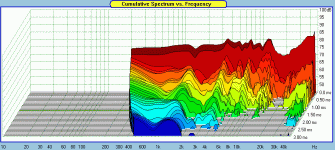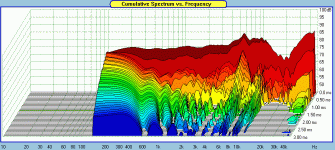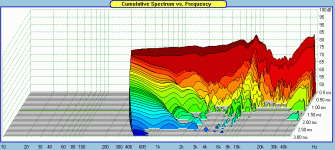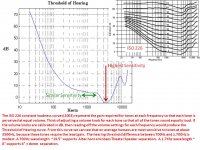Hmm thanks for posting. SB look to have reduced that dip for the 6.5" version. Even smoother! The MR 5" response looks not much different to the MW
Look at the specs it's essentially the same driver the only thing different is the shorter coil. What a cop out imo 2dB more sensitivity but nothing else. And 3mm xmax? Who needs that anyway, I'd rather it were 1.5mm for even more sensitivity in a mid application. Yawn.
It certainly looks less of a midrange than one might expect. A new underhung motor was always rather unlikely but a conventional midrange surround and, as you say, a shorter displacement? These would appear to be straightforward variations that a speaker manufacturer is likely to request which makes me curious about why the off-the-shelf driver is like it is. I am pretty confident SB Acoustics knows a lot more than me about what works for the market but it would be good to know.Look at the specs it's essentially the same driver the only thing different is the shorter coil. What a cop out imo 2dB more sensitivity but nothing else. And 3mm xmax? Who needs that anyway, I'd rather it were 1.5mm for even more sensitivity in a mid application. Yawn.
Good to see they finally have a datasheet up. Looks good.
I emailed SB and they said they'll be shipping them Q3 2016.
I emailed SB and they said they'll be shipping them Q3 2016.
I know that Scan, but it ain't no flapship.
Just because it doesn`t say "flagship" anywhere doesn`t make it one. The Revelator range is still considered a flagship by all means and is one of the best engineered widely distributed drivers.
I am waiting for a big big underhung midrange labeled Illuminator. If that Revelator's underhung, that's a flapship.
IMHO it's all about avoiding crossover in the 1-4 khz range,where the ear is most sensitive.
that's the reason why nowadays speakers sound so unnatural
Yes I miss my celestion dittons and spendor s100's
Can you explain more?
You said it's all about avoiding crossover in the 1-4 kHz range, where the ear is most sensitive, and that's the reason why nowadays speakers sound so unnatural.
Does this mean avoiding crossover in the 1-4khz range makes speakers sound unnatural?
He said he will buy the new Yamaha NS-5000 with mid dome driver 750 Hz to 4.5K Hz...with Zylon material (said to be even better than Beyrillium !)
That is a fallacy.Can you explain more?
You said it's all about avoiding crossover in the 1-4 kHz range, where the ear is most sensitive, and that's the reason why nowadays speakers sound so unnatural.
Does this mean avoiding crossover in the 1-4khz range makes speakers sound unnatural?
Thank you v much Samppo!
What a beast of a driver. Imagine those in a push pull.
Yeah they appear great, also the newest HobbyHifi magazine has a similar ad from SB Acoustics. I suppose the drivers should be readily available.
Why does the CDS for SB Acoustics drivers always look horrifying?
What's the point of having low distortion when the driver makes noise when it's not suppose to?
I've always chosen drivers based on transient response, especially in the lower frequencies where it gets really bad.
What am I missing?
BL looks low for all drivers, especially for the large neo, which Zaph The Great champions as: "the best performing motor in the business"
Couple SB drivers -- MW165DC-08N36 -- SB15MFC30-8 (middle)
And then Wavecor to compare -- WF152BD03-01 (right)
What's the point of having low distortion when the driver makes noise when it's not suppose to?
I've always chosen drivers based on transient response, especially in the lower frequencies where it gets really bad.
What am I missing?
BL looks low for all drivers, especially for the large neo, which Zaph The Great champions as: "the best performing motor in the business"
Couple SB drivers -- MW165DC-08N36 -- SB15MFC30-8 (middle)
And then Wavecor to compare -- WF152BD03-01 (right)
Attachments
Last edited:
You said it's all about avoiding crossover in the 1-4 kHz range, where the ear is most sensitive, and that's the reason why nowadays speakers sound so unnatural.
Scientific measurements creating the ISO 226 constant loudness curves(2003) provide one source of hearing sensitivity vs. frequency. The curve shows that on average humans are most sensitive to tones at about 3500 Hz, because these tones require the least gain to reach the threshold of hearing. Parents recognize this crying baby range. The hearing threshold difference between 700Hz and 1,700Hz is modest in the ISO226 test data. A 700Hz wavelength ~19.5" supports Altec horn+midbass separation Theater Speaker. A 1.7Khz wavelength ~ 8" supports 6" midrange + dome tweeter separation. Hearing sensitivity thresholds increase rapidly from ~2KHz to 5Khz. Timing and phase error discomfort increases rapidly above 2Khz, made worst by false queues generated by edge diffraction.
High tech speakers with low Le motors and reduced cone break-up have allowed new designs like Kairos, Kalasan, Mandolin which use 6"-6.5" midbass to maintain constant 180-degree baffle generated directivity with modern tweeters using ~1.7Khz crossovers --- just below the hearing threshold sensitivity cliff point.
Attachments
- Status
- Not open for further replies.
- Home
- Loudspeakers
- Multi-Way
- SB Acoustics Satori MR16P-4, a new hope for the big dark midrange world?




